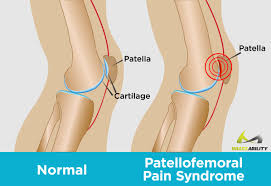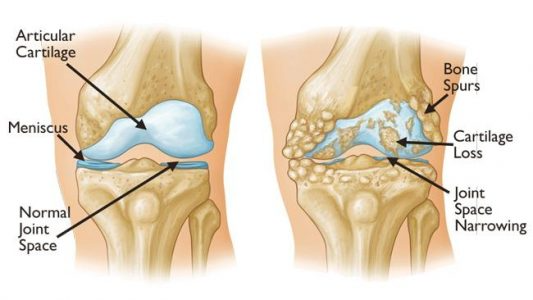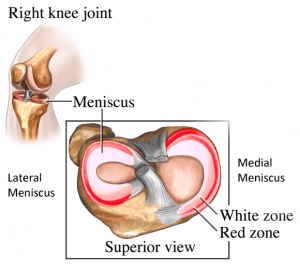Knee pain is caused by one or a combination of these three main causes…
Patellofemoral Pain Syndrome (PFPS)
Sometimes called “runners knee,” this is used to describe pain around the patella (kneecap) and in front of the knee. This is common in people who participate in sports that require running or jumping. Individuals at higher risk include women due to having a wider pelvis which puts increased stress at the knee joint, younger children playing sports as well the elderly due to the natural degenerative process that goes on at the knee cap.
Symptoms of PFPS include dull aching pain in the front of the knee which can be aggravated with walking up or down stairs, kneeling, squatting or sitting for periods of time.

Causes of PFPS include:
Overuse
Running or jumping sports put repetitive stress on your knee and can cause irritation under your patella.
Muscle imbalance or weakness
When the muscles surrounding your hip and knee are weak, they often do not keep your patella properly aligned which can cause irritation to the knee.
Trauma
Trauma to the patella, such as dislocation or fracture, has been known to cause PFPS due to malalignment.
How you can prevent PFPS injuries:
- Maintain strength of all muscles surrounding your knee and hips.
- Ensure good technique and alignment while performing exercises.
- Lose excess weight.
- Stretch – make sure the muscles surrounding the knee are at their proper length.
- Increase intensity of exercise/ activity gradually.
- Ensure you have proper fitting shoes.
Osteoarthritis
This is your classic “wear and tear” of the knee. As your knee arthritis progresses, bony spurs also develop in and around your knee joint in response to the change in load biomechanics.

Common causes of OA:
- Increasing age
- Above average weight
- Genetics
- Previous knee injuries
- Jobs or sports that repeatedly load the knee
Common symptoms of OA:
- Gradual onset of knee pain that is worse in the morning or after a period of inactivity like when sitting for a long period of time followed by getting up.
- Knee pain with weight-bearing tasks such as walking and stair-climbing.
- Knee stiffness or swelling.
- Clicking or grating.
- Decreased strength of the lower leg muscles.
Treatment may include:
- Normalizing range of motion of the entire lower extremity.
- Strengthen muscles in the hips, core, knees and ankles.
- Normalize muscle length through soft tissue mobilization and stretching.
- Improve balance and proprioception.
- Improve functional tasks such as squatting, lifting and push/pull tasks.
Meniscus Irritation
Your meniscus is fibrocartilage that separates the femur (upper leg bone) from your tibia (lower leg bone). It acts as a shock absorber as we walk, run and jump so that these forces don’t damage the bone surfaces.
Each knee joint has a medial meniscus and lateral meniscus. The medial meniscus is more likely to be injured because it is firmly attached to the MCL and joint capsule. The meniscus is likely to be torn or injured when the knee is in a compromised position such as twisting on a slightly flexed knee or natural age-related degeneration of the meniscus.
How you’ll know if you have a possible meniscal tear:
- Painful popping, clicking or locking of the knee.
- Pain with squatting, especially at the end of the range of motion.
- Tenderness along the joint line of the knee on examination.
- Unable to fully bend or straighten out the knee
Can your meniscus heal on its own?
Meniscus tear healing is dependent on the blood supply where the tear is. There are two “zones” that determine whether or not it will heal on its own.
Red zone: the red zone has blood supply, which means it can naturally heal. The outer edge of the meniscus has blood supply from the synovial capsule.
White zone: this is where the meniscus doesn’t have much or any blood supply and won’t heal naturally. Due to this, the inner meniscus does not usually heal and can trigger an inflammatory response which requires surgical attention.

Are you looking for more information and someone to tell you what is going on with your knee pain!? Come in for a free screen with one of our therapists.
It’s a 30 minute 1-on-1 appointment with a Physical Therapist where you get the following…
1. A DIAGNOSIS: Discover the cause of your pain so that you can attack the problem successfully.
2. A PROGNOSIS: Find out how long it will take to fix your knee pain for good so you can get back to all the activities you used to do before your injury.
3. A PLAN: Your Physical Therapist will lay out a clear plan that outlines what will be required to get you back to normal.
All you need to do to get started is to call (610) 839 – 8764 and pick your time and location. We look forward to meeting you and getting you back to normal!

